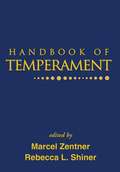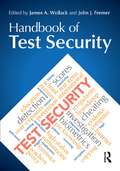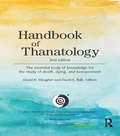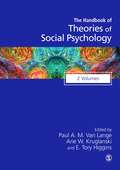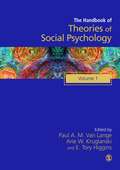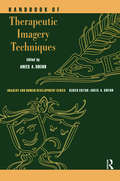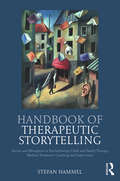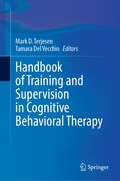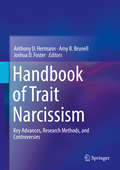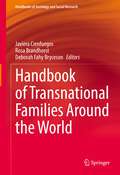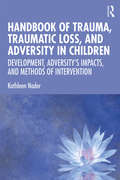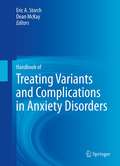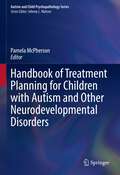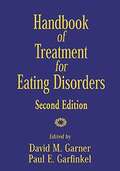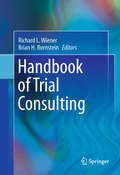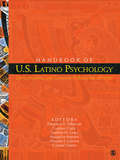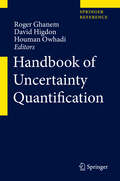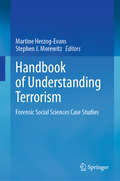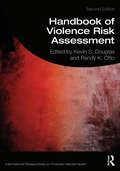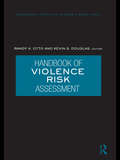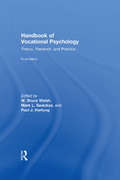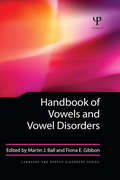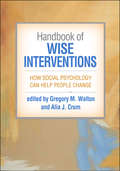- Table View
- List View
Handbook of Temperament
by Rebecca L. Shiner Marcel ZentnerTimely and authoritative, this unique handbook explores the breadth of current knowledge on temperament, from foundational theory and research to clinical applications. Leaders in the field examine basic temperament traits, assessment methods, and what brain imaging and molecular genetics reveal about temperament's biological underpinnings. The book considers the pivotal role of temperament in parent-child interactions, attachment, peer relationships, and the development of adolescent and adult personality and psychopathology. Innovative psychological and educational interventions that take temperament into account are reviewed. Integrative in scope, the volume features extensive cross-referencing among chapters and a forward-looking summary chapter.
Handbook of Test Security
by James A. Wollack John J. FremerHigh stakes tests are the gatekeepers to many educational and professional goals. As such, the incentive to cheat is high. This Handbook is the first to offer insights from experts within the testing community, psychometricians, and policymakers to identify and develop best practice guidelines for the design of test security systems for a variety of testing genres. Until now this information was scattered and often resided inside testing companies. As a result, rather than being able to learn from each other’s experiences, each testing entity was left to re-create their own test security wheel. As a whole the book provides invaluable insight into the prevalence of cheating and “best practices” for designing security plans, training personnel, and detecting and investigating misconduct, to help develop more secure testing systems and reduce the likelihood of future security breaches. Actual case studies from a variety of settings bring to life how security systems really work. Examples from both domestic and international programs are provided. Highlights of coverage include:• Best practices for designing secure tests• Analysis of security vulnerabilities for all genres of testing• Practical cheating prevention and detection strategies• Lessons learned in actual security violations in high profile testing programs. Part I focuses on how tests are delivered for paper-and-pencil, technology-based, and classroom testing and writing assessment. Each chapter addresses the prevalence of the problem and threats to security, prevention, and detection. Part II addresses issues essential to maintaining a secure testing program such as planning and monitoring, physical security, the detection of group-based cheating, investigating misconduct, and communicating about security-related issues. Part III examines actual examples of cheating-- how the cheating was done, how it was detected, and the lessons learned. Part III provides insight into security issues within each of the Association of Test Publishers’ four divisions: certification/licensure, clinical, educational, and industrial/organizational testing. Part III’s conclusion revisits the issues addressed in the case studies and identifies common themes. Intended for organizations, professionals, educators, policy makers, researchers, and advanced students that design, develop, or use high stakes tests, this book is also ideal for graduate level courses on test development, educational measurement, or educational policy.
Handbook of Thanatology: The Essential Body of Knowledge for the Study of Death, Dying, and Bereavement
by David E. Balk David K. MeagherIf ever there was an area requiring that the research-practice gap be bridged, surely it occurs where thanatologists engage with people dealing with human mortality and loss. The field of thanatology—the study of death and dying—is a complex, multidisciplinary area that encompases the range of human experiences, emotions, expectations, and realities. The Handbook of Thanatology is the most authoritative volume in the field, providing a single source of up-to-date scholarship, research, and practice implications. The handbook is the recommended resource for preparation for the prestigious certificate in thanatology (CT) and fellow in thanatology (FT) credentials, which are administered and granted by ADEC.
Handbook of Theories of Social Psychology: Collection: Volumes 1 & 2 (SAGE Social Psychology Program)
by Arie W. Kruglanski Dr E Tory Higgins Paul A. Van LangeProviding a comprehensive exploration of the major developments of social psychological theories that have taken place over the past half century, this innovative two-volume handbook is a state of the art overview of the primary theories and models that have been developed in this vast and fascinating field. Authored by leading international experts, each chapter represents a personal and historical narrative of the theory's development including the inspirations, critical junctures, and problem-solving efforts that effected theoretical choices and determined the theory's impact and its evolution. Unique to this handbook, these narratives provide a rich background for understanding how theories are created, nurtured, and shaped over time, and examining their unique contribution to the field as a whole. To examine its societal impact, each theory is evaluated in terms of its applicability to better understanding and solving critical social issues and problems.
Handbook of Theories of Social Psychology: Volume One (SAGE Social Psychology Program)
by Arie W. Kruglanski Dr E Tory Higgins Paul A. Van LangeThis innovative two-volume handbook provides a comprehensive exploration of the major developments of social psychological theories that have taken place over the past half century, culminating in a state of the art overview of the primary theories and models that have been developed in this vast and fascinating field. Authored by leading international experts, each chapter represents a personal and historical narrative of the theory's development including the inspirations, critical junctures, and problem-solving efforts that have effected the choices made in each theory's evolution as well as the impact each has had on the canon of social psychology. Unique to this handbook, these narratives provide a rich background for understanding how theories are created more generally; how they're nurtured and shaped over time: and how through examination we can better understand their unique contribution to society as a whole. The Handbook also illustrates how the various theories contribute to understanding and solving critical social issues and problems. The Handbook of Theories of Social Psychology is an essential resource for researchers and students of social psychology and related disciplines.
Handbook of Therapeutic Imagery Techniques (Imagery and Human Development Series)
by Anees Ahmad SheikhConsists of a description of a multitude of imagery techniques that have been grouped into four categories: hypno-behavioral, cognitive-behavioral, psychodynamic/humanistic and humanistic/transpersonal.
Handbook of Therapeutic Storytelling: Stories and Metaphors in Psychotherapy, Child and Family Therapy, Medical Treatment, Coaching and Supervision
by Stefan HammelThe Handbook of Therapeutic Storytelling enables people in the healing professions to utilise storytelling, pictures and metaphors as interventions to help their patients. Communicating in parallel worlds and using simple images and solutions can help to generate positive attitudes, which can then be nurtured and enhanced to great effect. Following an "Introduction" to the therapeutic use of stories, which closes with helpful "Instructions for use", the book is divided into two parts, both of which contain a series of easily accessible chapters. Part One includes stories with specific therapeutic applications linked to symptoms and situations. Part Two explains and investigates methods and offers a wide range of tools; these include trance inductions, adaptation hints, reframing, the use of metaphor and intervention techniques, how stories can be structured, and how to invent your own. The book also contains a detailed reference section with cross-referenced key words to help you find the story or tool that you need. With clear guidance on how stories can be applied to encourage positive change in people, groups and organisations, the Handbook of Therapeutic Storytelling is an essential resource for psychotherapists and other professions of health and social care in a range of different settings, as well as coaches, supervisors and management professionals.
Handbook of Training and Supervision in Cognitive Behavioral Therapy
by Mark D. Terjesen Tamara Del VecchioThis book provides a scientific and practical guide for training and supervision in cognitive behavioral therapy (CBT). It builds on more general fundamentals of clinical supervision with a theory-driven approach backed by empirical support for training and supervising clinicians in the practice of CBT. The book dispels the myth of “do it, teach it” as it relates to supervision and addresses the importance of recognizing that one size does not fit all with CBT supervision. The volume synthesizes CBT research on supervision and links it to the practice of supervision. It reviews components of supervision that warrant consideration (e.g., therapeutic alliance, ethics), specific settings (e.g., medical setting, schools) and clients (e.g., culture, individual, group, disability, and high-risk). In addition, it addresses a neglected area of developing competency, including developmental models as well as measuring trainee and supervisor competency in the provision of clinical supervision. The book recommends future directions on how to integrate technology into supervision to enhance the quality of supervision and, ultimately, client outcome. Key areas of coverage include: Major constructs in CBT supervision and training.Supervising work with various clients, including individuals, children, adolescents, families, and couples.Supervision and high-risk cases.Teaching and supervision within a behavioral medicine context.Issues of diversity, technology, and ethics of supervision.The Handbook of Training and Supervision in Cognitive Behavioral Therapy is an essential resource for researchers, professors, and graduate students as well as clinicians, therapists, and other professionals in clinical and school psychology, pediatrics, social work, developmental psychology, behavioral therapy/rehabilitation, child and adolescent psychiatry, nursing, and special education.
Handbook of Trait Narcissism: Key Advances, Research Methods, and Controversies
by Anthony D. Hermann Amy B. Brunell Joshua D. FosterThis unique reference surveys current theoretical and empirical advances in understanding individual differences in narcissistic personality, as well as the latest perspectives on controversies in the field. Wide-ranging expert coverage examines the many manifestations of narcissism, including grandiose, vulnerable, communal, and collective varieties. Narcissism’s etiology, the role of social media culture in its maintenance and amplification, and the complex phenomena of narcissistic leadership, spirituality, friendship, and love are just a snapshot of topics that are examined. The book’s section on intrapersonal processes delves into how the narcissistic mind works, as well as how narcissists feel about themselves and their peers. It also investigates narcissists’ grasp of emotions. Chapters explore associated personality traits and numerous other important correlates of narcissistic personality. New approaches to research, assessment methods, and opportunities for intervention—both immediate and long-term, are discussed throughout. In addition, trait narcissism is examined in an even-handed manner that incorporates state-of-the-art research into antecedents and consequences (both good and bad) of narcissistic personality.Among the topics in the Handbook:What separates narcissism from self-esteem? A social-cognitive perspective.The many measures of grandiose narcissism.Parents’ socialization of narcissism in children.What do narcissists know about themselves? Exploring the bright spots and blind spots of narcissists’ self-knowledge.Understanding and mitigating narcissists’ low empathy.Interpersonal functioning of narcissistic individuals and implications for treatment engagement. Offering nuanced analysis of a particularly timely subject, The Handbook of Trait Narcissism is fascinating and informative reading for psychologists and psychology students, as well as scholars in anthropology, sociology, economics, political scientists, and more.
Handbook of Transnational Families Around the World (Handbooks of Sociology and Social Research)
by Deborah Fahy Bryceson Javiera Cienfuegos Rosa BrandhorstThis handbook compiles the most up-to-date research on transnational families. It employs a dialogue between classical approaches and cutting-edge directions in transnational family research to identify continuities and changes in terms of socioeconomic disparities and actors, and to analyze coexistence. Further, the volume adopts a twofold global and international comparative perspective. On the one hand, it focuses on different migratory flows around the world and describes their entangled logics; on the other, it is written by an international group of contributors, with a diverse range of professional backgrounds. Their contributions are based on sound empirical research, and explore geographical regions around the world. The handbook presents different thematic perspectives on transnational families, including an analytical focus on gender, global sociodemographic inequalities, power asymmetries, and border- and mobility regimes, as well as the organization of transnational care, transnational fatherhood, ageing, family reunions and return. It also includes a variety of methodological approaches to transnational family research, ranging from ethnography, biographical research, and life-course methods, to multi-sited approaches and quantitative surveys. Investigating an emergent debate, it sheds new light on migratory fluxes, their common and specific determinants, the types of actors involved, and ways to empirically and methodologically approach them. This is a must-read reference for social scientists interested in family research, migration, and gender studies. Chapter 7 is available open access under a Creative Commons Attribution 4.0 International License via link.springer.com.
Handbook of Trauma, Traumatic Loss, and Adversity in Children: Development, Adversity’s Impacts, and Methods of Intervention
by Kathleen NaderThe Handbook of Trauma, Traumatic Loss, and Adversity in Children is a developmentally oriented book rich with findings related to child development, the impact of trauma on development and functioning, and interventions directed at treating reactions to trauma. Aspects of attachment and parenting and the use of interrelationships toward therapeutic ends are included in each age-related section of the book, ranging from 0 to 18+. Consolidating research from a range of disciplines including neurobiology, psychopathology, and trauma studies, chapters offer guidance on the potentially cascading effects of trauma, and outline strategies for assisting parents and teachers as well as children. Readers will also find appendices with further resources for download on the book’s website. Grounded in interdisciplinary research, the Handbook of Trauma, Traumatic Loss, and Adversity in Children is an important resource for mental health researchers and professionals working with children, adolescents, and families during the ongoing process of healing from traumatic exposure.
Handbook of Traumatic Loss: A Guide to Theory and Practice
by Neil Thompson Gerry R. Cox Robert G. StevensonThe Handbook of Traumatic Loss adopts a broad, holistic approach that recognizes traumatic loss much more fully as a multidimensional human phenomenon, not simply a medical condition. Initial chapters build a foundation for understanding traumatic loss and explore the many ways we respond to trauma. Later chapters counterbalance the individualistic focus of dominant approaches to traumatic loss by highlighting a number of thought-provoking social dimensions of traumatic loss. Each chapter emphasizes different aspects of traumatic loss and argues for ways in which clinicians can help deal with its many and varied impacts.
Handbook of Treating Variants and Complications in Anxiety Disorders
by Dean Mckay Eric A. StorchAs prevalent as anxiety is as a diagnosis, clinically complex cases are even more so. At the same time that it is recognized as a spectrum of disorders with many possibilities for intervention, it is most often seen with variations that further complicate treatment. The Handbook of Treating Variants and Complications in Anxiety Disorders explains in clear detail how and why clinical factors present challenges to clinicians treating clients with these disorders. Comorbid conditions often found in children, adolescents, and adults with anxiety, including developmental disabilities and personality disorders, are analyzed in the context of treatment. Case examples and literature reviews illustrate the relative merits of integrated versus sequential treatment, the importance of prioritizing behaviors, age-related considerations, and therapist issues. This best-practices approach guides readers in choosing current evidence-based options for treatment that is tailored to the individual and effective in the short and long term. Included in the Handbook: Prognostic indicators of treatment response for children and adults with anxiety disorders.Treatment of comorbid anxiety and disruptive behavior in youth.Treatment of PTSD with comorbid borderline personality disorder.Limited motivation, patient-therapist mismatch, and the therapeutic alliance.Assessment and treatment of comorbid anorexia nervosa and obsessive compulsive disorder.Treatment of comorbid anxiety disorders across the lifespan. Developed as a companion reference to the Handbook of Assessing Variants and Complications in Anxiety Disorders, the Handbook of Treating Variants and Complications in Anxiety Disorders is of immediate relevance to researchers, scientist-practitioners, and graduate students in clinical child, school, and developmental psychology; social work; psychiatry; psychotherapy; counseling; and pediatrics.
Handbook of Treatment Planning for Children with Autism and Other Neurodevelopmental Disorders (Autism and Child Psychopathology Series)
by Pamela McPhersonThis handbook addresses treatment planning for children with autism spectrum disorder (ASD) and other neurodevelopmental disabilities (NDDs) using a medical home perspective. It examines the medical home model, which has been promoted as the standard of care by the American Academy of Pediatrics since 2002, emphasizing collaboration between patients, families, and providers to optimize care. The handbook addresses treatment planning, including the coordination of the care provided by multiple specialists with a clear, shared vision for maximizing each child’s potential.Key areas of coverage include:· Elements of treatment planning, history of the medical home model, documentation, and strategies to facilitate communication.· Goals of treatment from the perspectives of the family, person served, care providers, and fiscal and regulatory bodies.· Role of each specialist, highlighting the most common conditions experienced by children with ASD and other NDD with expectations for assessment and treatment.· Detailed recommendations for making referrals and assisting the child and family in preparing for appointments.The Handbook of Treatment Planning for Children with Autism Spectrum Disorder and Other Neurodevelopmental Disabilities is a must-have resource for researchers, professors, and graduate students as well as clinicians, therapists, and other professionals across such interrelated disciplines as clinical child, school, and developmental psychology, child and adolescent psychiatry, social work, rehabilitation medicine/therapy, pediatrics, and special education.
Handbook of Treatment for Eating Disorders
by Paul E. Garfinkel David M. GarnerIn this seminal work, leading clinicians and researchers present the major treatments for eating disorders, including cognitive-behavioral, educational, psychodynamic, feminist, family-based, and medical approaches. <p><p>Therapeutic approaches are described in step-by-step detail and illustrated with extensive case material. Several chapters function as self-contained treatment manuals, enabling practitioners to easily learn and implement each model, as well as adapt it to suit the needs of individual patients. The volume also covers diagnosis, assessment, sequencing of treatments, and ways to manage frequently encountered co-occurring problems.
Handbook of Trial Consulting
by Brian H. Bornstein Richard L. WienerThis volume will be a handbook that treats trial consulting as applied psychology. The purpose of the volume will be to collect the viewpoints of leaders in the field of psychology and law who apply the discipline's theoretical models, methods, and ethics to assist litigators to try cases in the most effective way possible. As a whole, the collection of chapters will describe the theory, business, and mechanics of trial consulting for those interested in learning and practicing the profession. However, it will do so from the perspective of organized theories of jury-decision making. In other words, the work of juror researchers will inform the recommendations and suggestions in the handbook. The volume consists of six sections, each pertaining to a different topic. Multiple chapters with different authors will cover each topic. The topics and corresponding seven sections will be 1) An Introduction to the Theory and Psychology of Jury Decision-Making, 2) Applied Research Methodologies for Trial Consultants, 3) Education and Ethical Considerations for Trial Consultants, 4) Preparing and Cross Examining Witnesses, 5) Technology and Demonstrative Evidence at Trial, and 6) Special Topics in Trial Consulting. Each section will begin with the editors' short introduction reviewing that section and explaining its goals, objectives, and content. Separate individuals, recognized as leaders in their areas will write the remaining chapters in each section. These individuals come from the fields of both psychology and law, and represent viewpoints on these topics from a practice-oriented perspective, but a perspective that is emerges from research results. They are affiliated with a number of academic institutions, including University of Nebraska, John Jay College of Criminal Justice, University of Texas, University of Chicago Simon Fraser University, and private law firms.
Handbook of U.S. Latino Psychology: Developmental and Community-Based Perspectives
by Gustavo Carlo Dr Francisco A. Villarruel Dr Josefina M. Grau Margarita Azmitia Professor Natasha Cabrera Dr T. Jaime ChahinCongratulations to Aida Hurtado and Karina Cervantez- winners of the 2009 Women of Color Psychologies Award! This award, given by the Association of Women in Psychology Association, is voted on by AWP members for contributions of new knowledge and importance to the advancement of the psychology of women of color. Offering broad coverage of all U.S. Latino groups, this volume synthesizes cutting-edge research and methodological advances and provides culturally sophisticated information that can be used by researchers, policy makers, and practitioners. The editors and contributing authors summarize theories and conceptual models that can further our understanding of the development and adaptation of U.S. Latino populations. In addition, they focus on the importance of cultural sensitivity and competence in research and intervention approaches and how to achieve it. Key Features• Highlights the normative development and strengths of U.S. Latino populations • Elaborates on the heterogeneity of Latinos in that it does not assume that all Latino populations, and the contexts of their development, are identical. • Emphasizes on cultural sensitivity and competence at all levels• Focuses on the importance of cultural identity amongst Latinos and its contribution to healthy developmental outcomes.
Handbook of Uncertainty Quantification
by David Higdon Roger Ghanem Houman OwhadiThe topic of Uncertainty Quantification (UQ) has witnessed massive developments in response to the promise of achieving risk mitigation through scientific prediction. It has led to the integration of ideas from mathematics, statistics and engineering being used to lend credence to predictive assessments of risk but also to design actions (by engineers, scientists and investors) that are consistent with risk aversion. The objective of this Handbook is to facilitate the dissemination of the forefront of UQ ideas to their audiences. We recognize that these audiences are varied, with interests ranging from theory to application, and from research to development and even execution.
Handbook of Understanding Terrorism: Forensic Social Sciences Case Studies
by Stephen J. Morewitz Martine Herzog-EvansThis book examines common theoretical conceptualization of terrorism, including all the following dimensions: Macro-criminological theories Psycho-criminological models of aggression Psycho-criminological models of risk and need (RNR) Psychopathology Social psychology, particularly in the areas of intergroup relations, identity, need for closure, and, the quest for significance Ideological and religious passions and extremism International in scope, each chapter draws on a combination of these frameworks, exemplified in a collection of case series and studies, to help students, practitioners, and researchers better understand these phenomena.
Handbook of University and Professional Careers in School Psychology (Consultation, Supervision, and Professional Learning in School Psychology Series)
by Randy G. Floyd; and Tanya L. EckertThe Handbook of University and Professional Careers in School Psychology is a comprehensive resource for school psychologists in doctoral training or currently appointed to positions in universities and other clinical professional settings. Across 30 unique chapters, experts in the field offer diverse, experienced perspectives on accessing resources, building skills, navigating difficult experiences, and flourishing in all major facets of the profession. The book places special emphasis on development throughout the career lifespan and the empowerment of women, people of color, and scholars from outside of the United States.
Handbook of Violence Risk Assessment (International Perspectives on Forensic Mental Health)
by Kevin S. Douglas; Randy K. OttoThe Handbook of Violence Risk Assessment, Second Edition, builds on the first edition’s comprehensive discussion of violence risk assessment instruments with an update of research on established tools and the addition of new chapters devoted to recently developed risk assessment tools. Featuring chapters written by the instrument developers themselves, this handbook reviews the most frequently used violence risk assessment instruments—both actuarial and structured professional judgment—that professionals use to inform and structure their judgments about violence risk. Also included are broader chapters that address matters such as the consideration of psychopathy and how the law shapes violence risk assessment. Already the primary reference for practitioners, researchers, and legal professionals in this area, this second edition’s easy-to-access, comprehensive, and current information will make it an indispensable reference for those in the field.
Handbook of Violence Risk Assessment (International Perspectives on Forensic Mental Health)
by Randy K. OttoThis comprehensive Handbook of original chapters serves as a resource for clinicians and researchers alike. Two introductory chapters cover general issues in violence risk assessment, while the remainder of the book offers a comprehensive discussion of specific risk assessment measures. Forensic psychology practitioners, mental health professionals who deal with the criminal justice system, and legal professionals working with violent offenders will find the Handbook of Violence Risk Assessment to be the primary reference for the field.
Handbook of Vocational Psychology: Theory, Research, and Practice (Contemporary Topics In Vocational Psychology Ser.)
by W. Bruce Walsh Mark L. Savickas Paul J. HartungHandbook of Vocational Psychology identifies, reports, and evaluates significant developments in vocational psychology and career counseling, and in doing so provides both professional clinicians and students with an informed understanding of both the current state and continuing progress in the field. As in previous editions, the fourth edition links theory and research with the more applied aspects of this field: four sections cover, in order, the field's history, theory, research, and practical applications. Clinicians, students, and academics at all levels of experience will find that the Handbook of Vocational Psychology, 4th ed, paints an accurate picture of the realities of work and serves as a practical reference work for anyone interested in keeping up to date with the latest research and trends in vocational psychology.
Handbook of Vowels and Vowel Disorders
by Martin J. Ball Fiona E. GibbonIn the general study of speech and phonetics, vowels have stood in second place to consonants. But what vowels are, how they differ from one another, how they vary among speakers, and how they are subject to disorder, are questions that require a closer examination. This Handbook presents a comprehensive, cogent, and up-to-date analysis of the vowel, including its typical development in children's speech, description by perceptual and instrumental methods, cross-linguistic and sociolinguistic aspects, and disorders of its production and use. It approaches the problems of vowel production and perception from the viewpoints of physiology, physics, psychology, linguistics, phonetics, phonology, and speech-language pathology. The chapters are logically complementary, and the major sections of the book are like key dimensions of understanding, each adding a perspective and base of knowledge on vowels. The sum total of the chapters is a synthesis of information on vowels that has no precedent.
Handbook of Wise Interventions: How Social Psychology Can Help People Change
by Gregory M. Walton and Alia J. CrumPrecise shifts in the ways people make sense of themselves, others, and social situations can help people flourish. This compelling handbook synthesizes the growing body of research on wise interventions--brief, nonclinical strategies that are "wise" to the impact of social-psychological processes on behavior. Leading authorities describe how maladaptive or pejorative interpretations can undermine people&’s functioning and how they can be altered to produce benefits in such areas as academic motivation and achievement, health, well-being, and personal relationships. Consistently formatted chapters review the development of each intervention, how it can be implemented, its evidence base, and implications for solving personal and societal problems.
